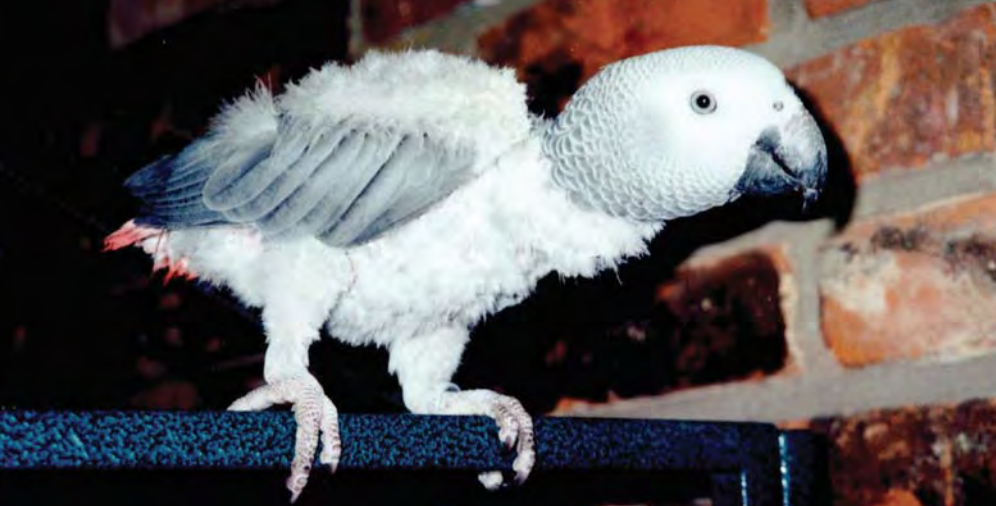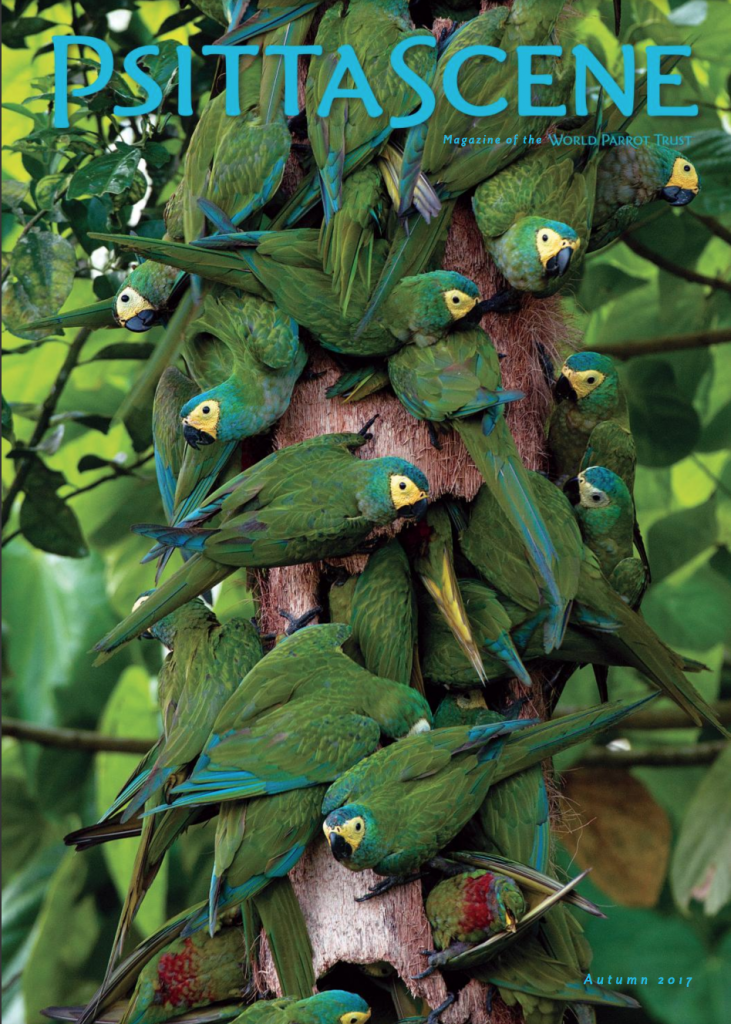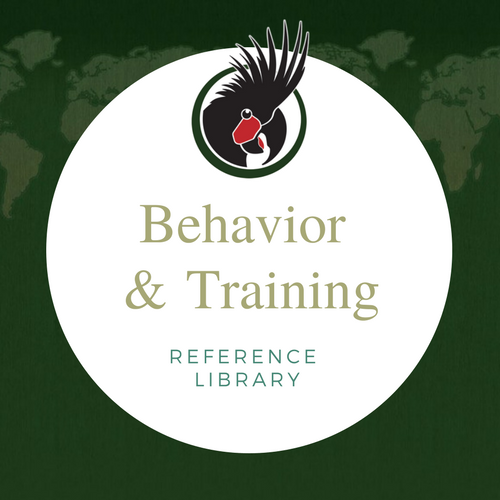
Feather Destructive Behavior - Finding Solutions
From the Winter 2011 Edition of PsittaScene Magazine. Get a free subscription with your WPT membership.
CLEO WAS JUST 13 MONTHS OLD when I first met her – a perfect feminine African Grey head perched atop a scruffy body – most feathers removed including her tail and primary flight feathers. Her caregiver came to me distressed and feeling guilty, unsure of what was wrong and desperate to help his beloved grey.
Feather destructive behavior (FDB) has become quite common among companion parrots. It has also become a widely accepted behavior – just “something that captive parrots do.” Caregivers, frustrated by their unsuccessful attempts to stop the behavior, instead capitulate into acceptance, reassuring themselves that at least the parrot seems happy and healthy otherwise. This is a case of the “bad becoming normal,” to borrow a phrase from author and respected behavior expert Temple Grandin. When any parrot destroys his own feathers, it is a sign that something is wrong and intervention is needed. While not every case of FDB can be resolved, many can by performing an holistic, comprehensive examination of every aspect of the parrot’s life and making improvements where indicated.
The definition of FDB, a.k.a. feather picking, is any self-inflicted destruction of feathers. This may include pulling feathers out completely with the beak or feet, chewing them off at the body, barbering (snipping away small pieces), or shredding the barbules off of the central shaft. It does not include self-mutilation (chewing into the skin itself to create a wound). While feather destruction and self-mutilation can occur in the same individual, FDB does not necessarily lead to self-mutilation.
Frequently, solutions elude caregivers because there is not a full recognition of the complexity of the problem. In most cases, several factors work together to push the bird over the edge into this extreme behavior. There is usually also a trigger, a particular event that initiates the behavior. For example, as it turned out Cleo had been weaned too early onto a seed-based diet, was given a too-short wing trim, and did not receive the enrichment that would have led to the development of behavioral independence. At age six months, the owner left for an extended period, leaving her with an unfamiliar caregiver, at which time she began chewing off feathers. The owner’s absence was blamed, when in fact it was the other conditions and experiences that predisposed Cleo to developing the problem.
Risk factors for FDB can be divided into medical vs. non-medical causes. I often hear the term “behavioral” used to describe an individual’s feather destruction. However, this term is useless and should be avoided. We know that feather destruction is a behavior. Therefore, this label tells us nothing and does in fact bring us to a dead end, in terms of identifying possible solutions.
Feather Destructive Behavior, commonly termed “feather picking,” is any self-inflicted destruction of feathers. Whilst it has come to be accepted by many caregivers, it is a sign that something is wrong and intervention is needed.
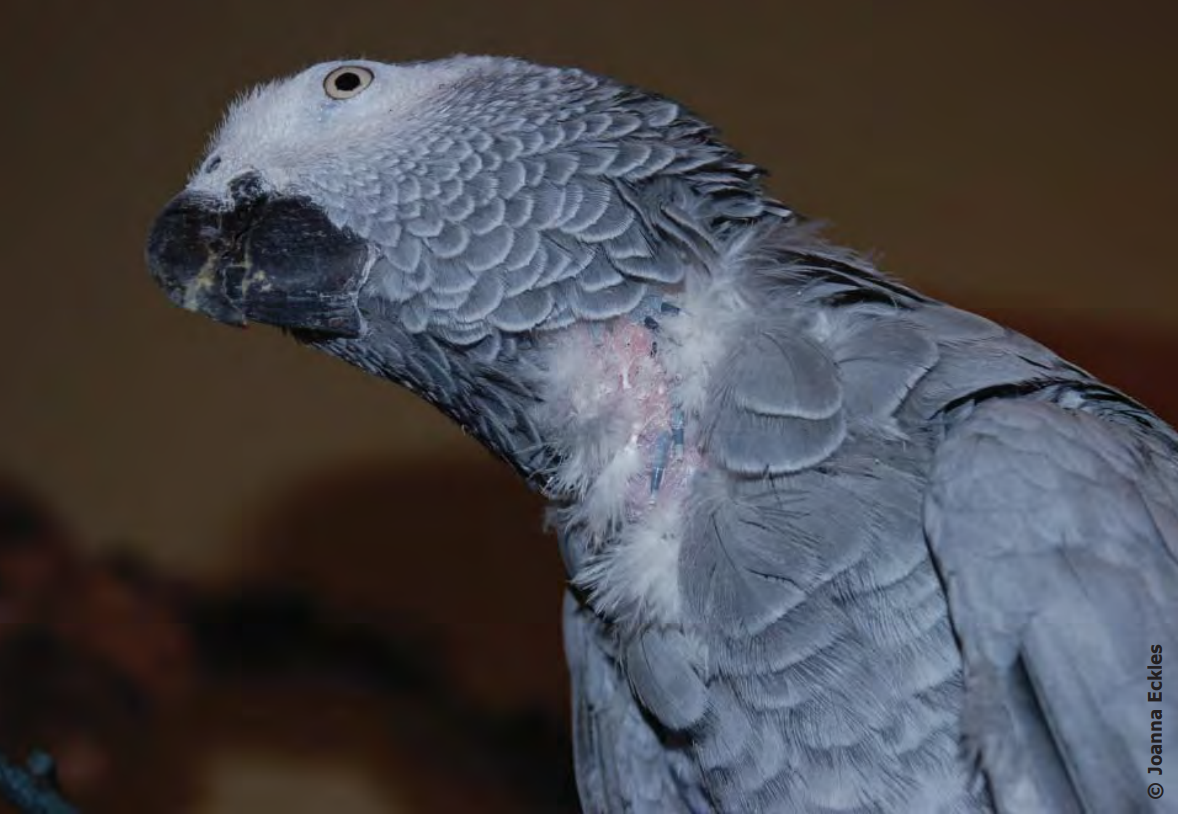
Medical causes can include
(1) infection (bacterial, viral, fungal or parasitic),
(2) metabolic disorders (liver disease),
(3) endocrine conditions (thyroid dysfunction),
(4) tumors, or
(5) metal toxicity.
Non-medical causes include
(1) inappropriate diet,
(2) chronic stress or anxiety,
(3) increased production of reproductive hormones,
(4) lack of independent play skills that leads to boredom or over-dependence upon the owner,
(5) inadequate bathing opportunities,
(6) lack of adequate rest,
(7) insufficient exercise,
(8) insufficient opportunity for learning and making choices,
(9) lack of foraging and other “discovery” opportunities,
(10) lack of access to fresh air and sunshine, and
(11) foreign substances on feathers or exposure to toxic materials, such as cigarette smoke.
Even if your parrot is not currently damaging his feathers, any of these factors, if present, should be corrected now, in order to prevent the problem from occurring in the future.
Certain clues as to cause can be derived by observing where on the body the behavior begins and when it occurs during the day. A parrot who starts chewing off wing and tail feathers, or who barbers feathers, is likely doing so for non-medical reasons. A parrot who destroys feathers over the torso could be doing so for either non-medical or medical reasons. A parrot who destroys feathers only at night when supposed to be asleep may, in fact, be suffering from a physical ailment that causes discomfort when the distractions of the day are no longer present.
Regardless of any such clues, the first step to resolving a FDB problem must be to have a thorough work-up done by an avian veterinarian experienced with this problem. If you take your parrot to a vet and no diagnostic testing is recommended, seek a second opinion. It is not possible to rule out medical causes by simply doing a physical exam. While there is no recognized protocol for working up a feather picking parrot, typical testing might include a complete blood count, chemistry panel, Gram stain or culture and sensitivity, fecal analysis and possibly radiographs.
After ruling out medical causes, the best chance at resolution is to then examine each of the areas listed below and to make improvements where necessary.
Diet & Nutrition
Parrots eating a seed mix as a staple in the diet, or who regularly consume relatively high amounts of fat and carbohydrates, are at risk for FDB. Seed mixes contain insufficient amounts of vitamin A to support the immune system, and are so high in fat as to predispose a parrot to conditions like fatty liver disease. You must transition the parrot from the seed mix onto a high-quality formulated diet and then supplement with a moderate amount of live, raw, fresh foods, with the focus on vegetables, greens, and grains. Teaching a parrot to eat a better diet is just that – a training issue. If not able to make this transition successfully on your own, then seek the assistance of a professional who knows how to do so effectively without causing the parrot undue stress in the process.
The overall amount of fats and carbohydrates in the diet must be limited. Parrots are instinctively “programmed” to load up on these foods. This serves them well in the wild, where energy expenditures are significant. However, in captivity these same parrots easily become carbohydrate “junkies” demanding daily their ration of white rice, mashed potatoes, fruit and pasta. The best rule of thumb is to avoid feeding any food that contains white flour, that has any form of sugar listed in the first five ingredients, or that contains any trans fat. Very sweet fruits, such as bananas and grapes, should be avoided in favor of those that offer better nutrition, such as berries.
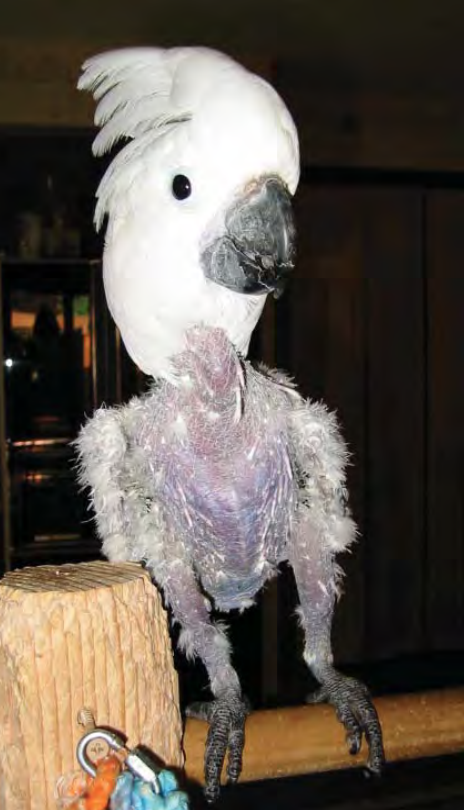
© Photos courtesy of Pamela Clark
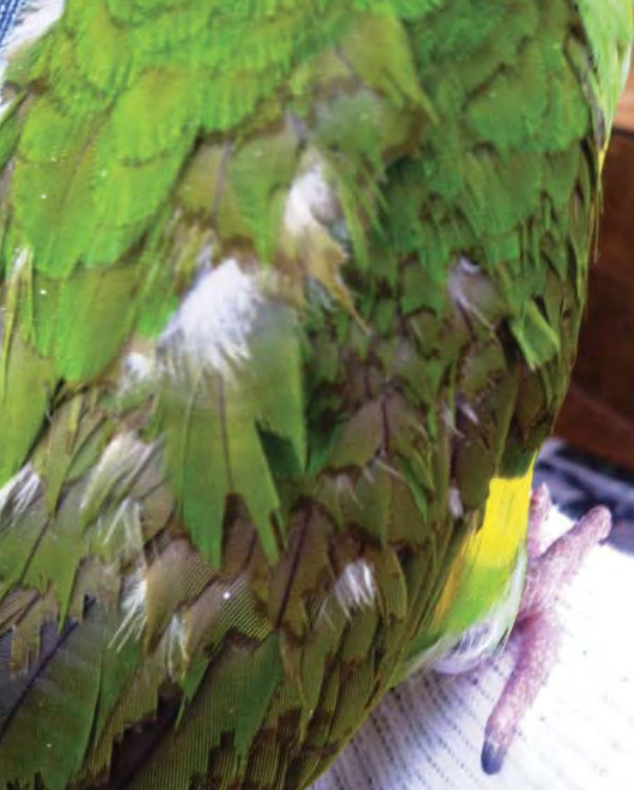
Feather destruction may include pulling feathers out completely with the beak or feet, chewing them off at the body, snipping away small pieces (barbering), or shredding the barbules off of the central shaft.
Chronic Stress & Anxiety
All companion parrots experience some stress because they are captive, living in a state of chronic restraint. This stress can be increased dangerously by many conditions present in our homes. These range from remodeling projects, threats from other parrots, cages placed in front of windows, the presence of rodents at night, to an inability to fl y away from perceived threats if the wings are trimmed. A thorough and objective analysis of the environment must be undertaken to identify causes of stress. Then, practical changes should be made where possible, without becoming overprotective of the parrot. If a friend visits wearing a hat and the parrot is afraid of the hat, you would have the friend remove it. Hats are not necessary to quality of life for a parrot. On the other hand, if a new toy creates a fear reaction, you will need to implement a desensitization plan allowing him to get used to looking at it first, then finally learn that it has entertainment value.
A significant source of stress for most companion parrots is their inability to fly. A parrot who cannot move about at will is not able to make the steady stream of behavioral choices that is his birthright, and knows instinctively that, should danger manifest, he is unable to get away.
It is my hope, as we move into a more modern and benevolent manner of caring for companion parrots, that each parrot will be evaluated as a candidate for flight and that having flighted parrots indoors will one day be the norm, as it is in other countries. Certainly, there is risk in the home for a flighted parrot, but there is also risk for parrots whose wings are clipped. Maintaining a flighted bird can be done safely through wise arrangement of the environment and effective training within the home. Transitioning a clipped parrot to a flighted status should be done with the help of a professional who lives successfully with flighted birds.
Production of Reproductive Hormones
This is perhaps the most common factor contributing to FDB in adult parrots. Wild parrots naturally live in a hormonally inactive state for most of the year. They are triggered into a reproductive status when environmental conditions converge that support breeding and rearing young. Unfortunately, these same triggers are often present continually in our homes.
The primary triggers caregivers provide that increase production of reproductive hormones are:
(1) the presence of a pair bond (usually between the parrot and a human in the home),
(2) the ability to engage in interactions of an affectionate nature with that bonded one (cuddling, stroking down the back and under the wings, shoulder time),
(3) the presence of a perceived nesting area (access to closets, drawers, cupboards, sleeping huts, cardboard boxes, etc.),
(4) a nutrient-dense diet that contains too many carbohydrates and fats, or too much food overall, and
(5) a degree of sameness to the environment (no challenges to accept new experiences).
An additional trigger can be the presence nearby of other parrots also in a reproductively active state.
Increased hormone production is a fundamental and primary problem that leads to several problem behaviors, in addition to FDB. Therefore, making changes in this area is critical. If you think your parrot has developed a pair bond with you, try to evolve that bond through reducing time on the shoulder, reducing and then eliminating cuddling. Instead engage in trick training or other activities that will cause your bird to relate to you in a different manner. Also discourage any sexual behaviors, such as regurgitation or rubbing of the vent against clothing or hands, by relocating the parrot to another perch and redirecting him to more appropriate behavior.
Many caregivers provide cardboard boxes, empty out drawers, or allow their parrots to play in closets out of the perception that this makes the parrot very happy. It does. Parrots get very excited at the opportunity to even sit in perceived nesting areas. However, this must be consistently discouraged. A parrot allowed access to such areas will not only suffer the attendant surge in hormone production that such exciting activities trigger, but will soon begin to display a form of territoriality about these areas that often becomes quite inconvenient for the owner who wants to get another pair of shoes out of the closet.
Recovery is possible! This is the same bird pictured earlier with feather destruction completely resolved. Resolution first requires a thorough analysis of every aspect of the parrot’s life.
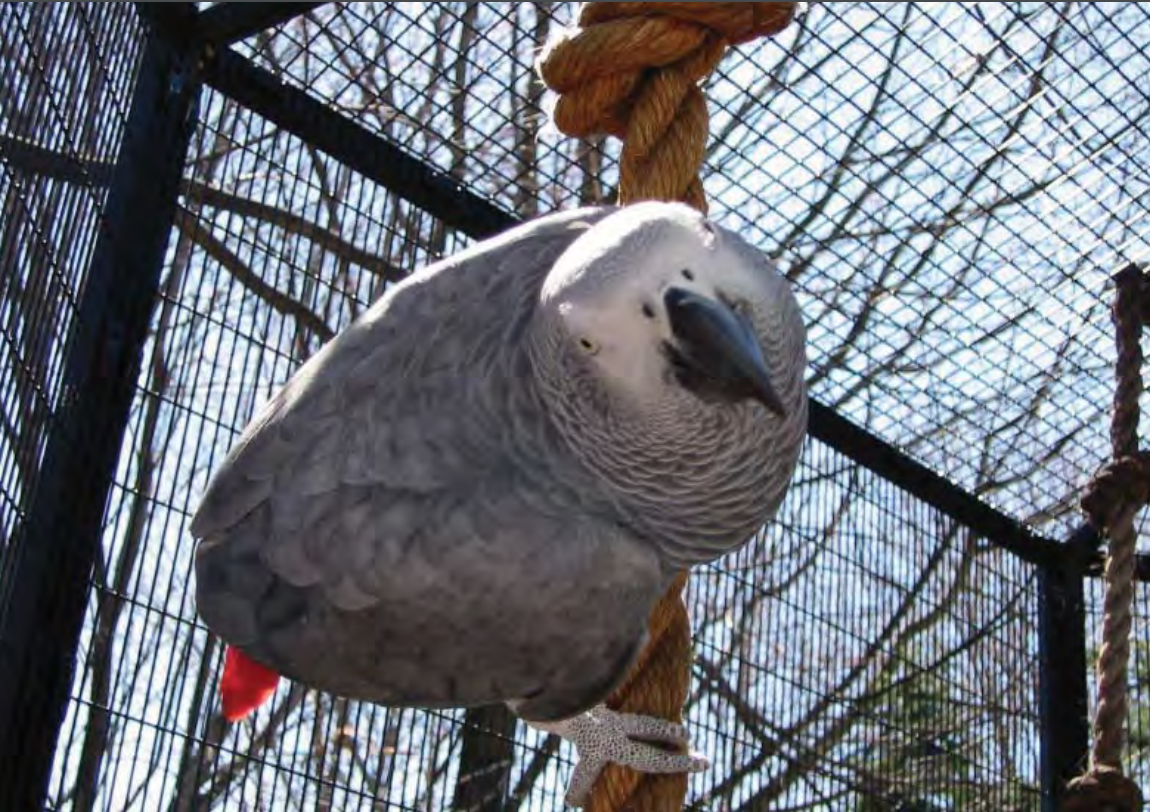
Bathing, Fresh Air & Sunshine
I will discuss these together because all contribute greatly to feather quality. Many cases of feather damaging behavior can be improved simply by increasing bathing opportunities. Parrots should be bathed in the morning so that they have plenty of time to dry before going to bed at night. A daily bath can be provided to those parrots who enjoy this. At minimum, a weekly bath should be encouraged. Access to an outdoor aviary where the parrot will experience wind, rain and sun will also help to encourage normal preening.
Rest
Requirements for rest vary among individuals and species. Young parrots, or those originally from the New World, are likely to need at least ten hours of sleep a night. Adult African Greys and some cockatoos often do well with only eight to nine hours of rest. Caregivers must use common sense in this area and realize that, while we can extend day length artificially, our parrots would naturally be sleeping during the hours of darkness.
Exercise
A parrot allowed flight will exercise himself naturally. Encouraging exercise for parrots with clipped wings can be challenging. However, certain hanging perches can help. Examples are swings which encourage flapping and ladders that encourage climbing. Some parrots will enjoy playing fetch or hide and seek on the floor.
Foreign or Toxic Substances
Caregivers must maintain an awareness that substances transferred onto feathers by hands can be unpleasant for parrots. Avoid snacking while petting your parrot. Wash hands thoroughly every time after smoking.
Next Steps
Once you have evaluated the areas detailed above and made changes where needed, it is time to tackle the single most important area for a successful resolution of the problem – behavior modification and training. This includes providing appropriate enrichment and then teaching the parrot to stay busy which will be discussed in PART TWO.
Page 1 of 2
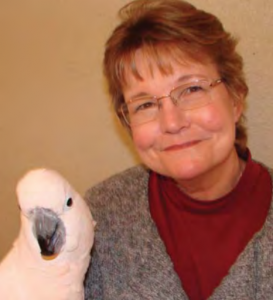
Pamela Clark (CVT) is a well-known author, speaker, and parrot behaviour consultant whose experience with parrots dates over 45 years to the purchase of her first pair of lovebirds. Her special interests include feather destructive behaviour, training, flight and nutrition.
This article was originally published November 2011 in PsittaScene magazine.
© Copyright 2018 World Parrot Trust. All Rights reserved.
